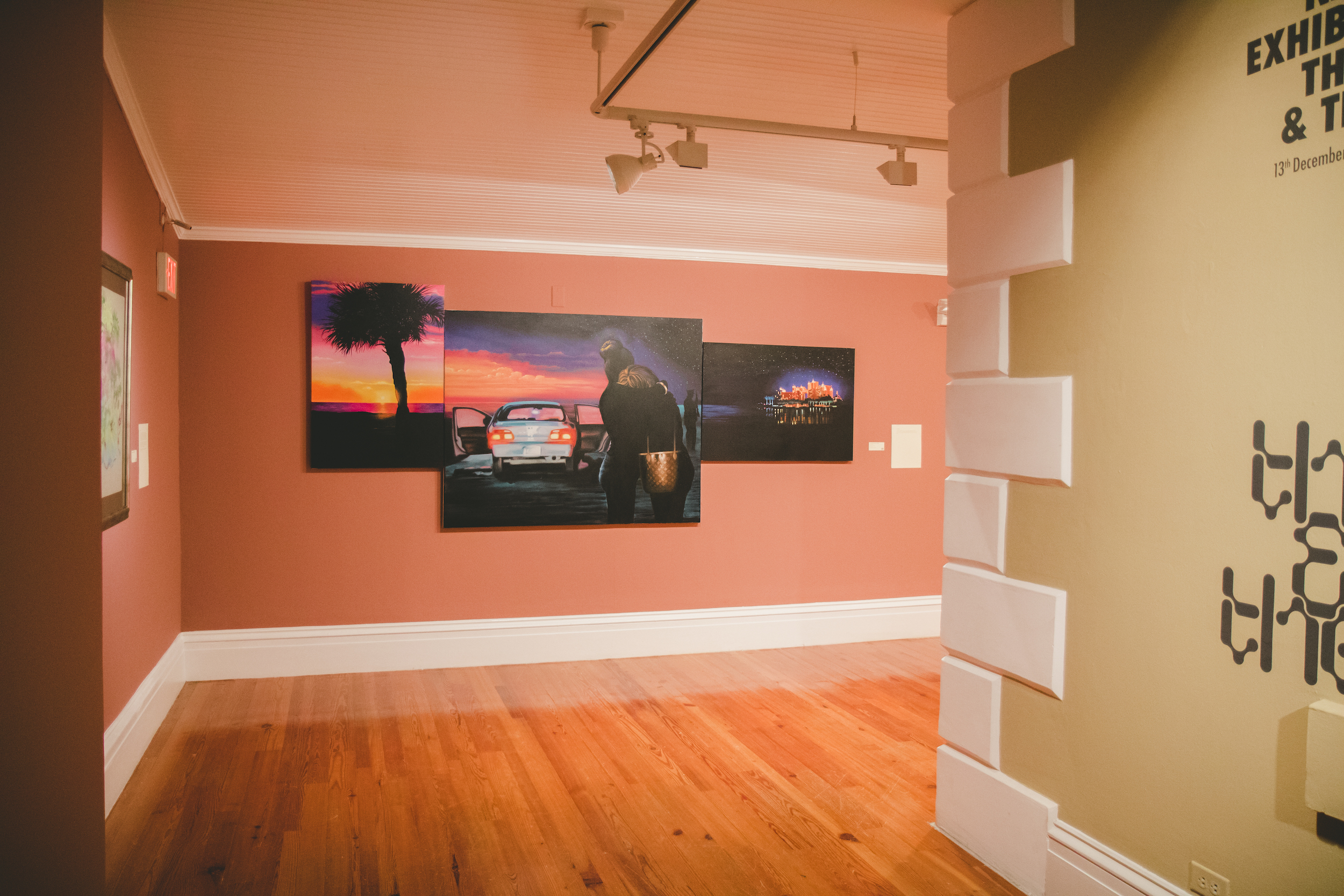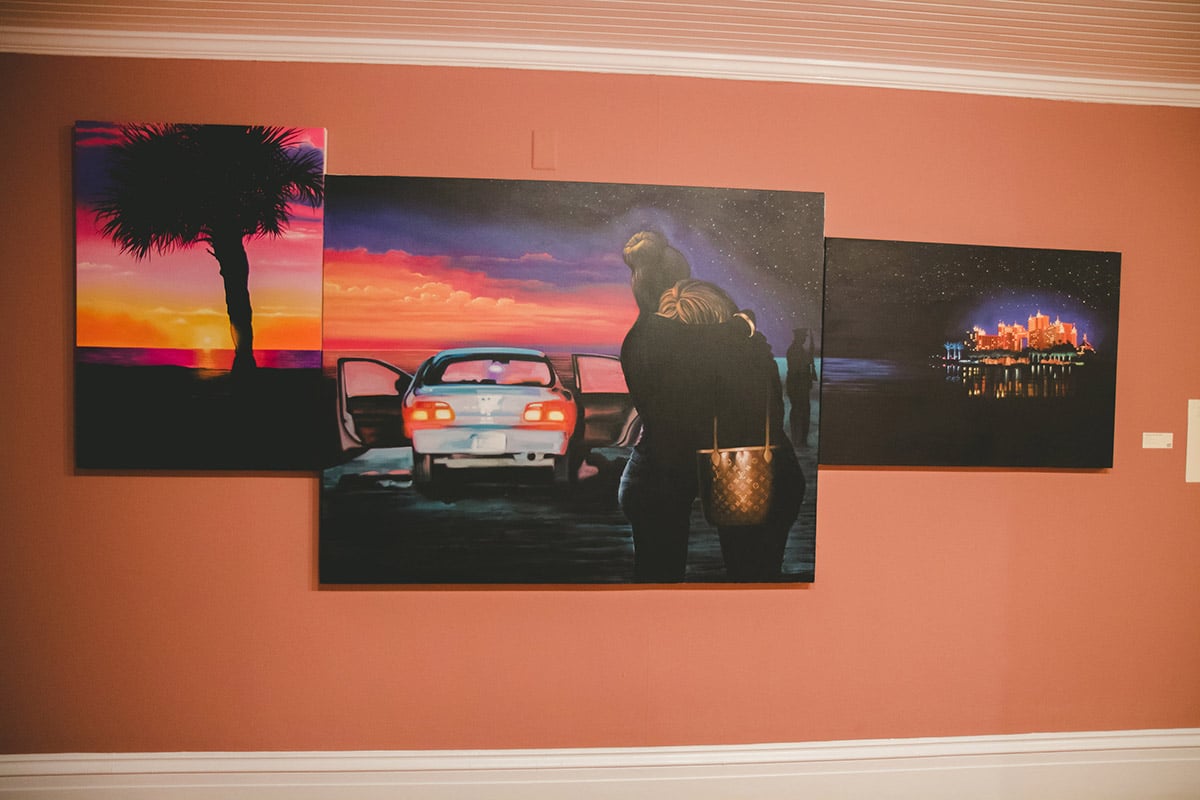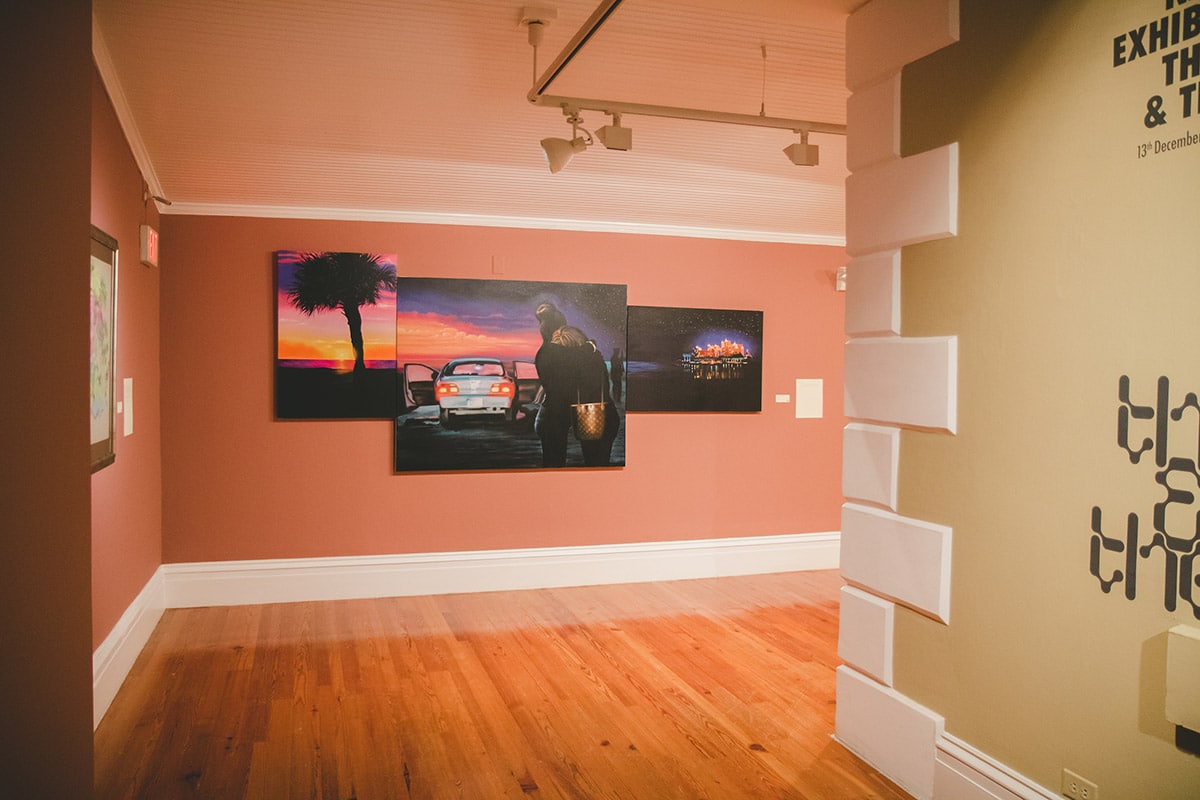
By Dr Ian Bethell-Bennett
The University of The Bahamas
In the Caribbean, like most of the world with globalisation’s flattening of the world, as Thomas Friedman’s The World is Flat (2005), demonstrates, inequality increases as the local place is transformed by the international space. Art and the art scene belie the international and interstitial connectivity of local and global.
Dave Smith’s Caribbean Sunrise (2018), is emblematic of this using juxtaposition and colour in striking yet contradictory and discordant ways. We never think of the Caribbean as a violent space, yet with this history of occupation and exploitation is is quintessentially violent, it’s geography hides violence: the violence of the encounter or the discovery, that in itself marks a violent erasure of what was once there, though overlaying it with a imagery and imaginary of paradise, almost like Milton’s Paradise Lost (1667). The allure is dangerous.

‘Caribbean Sunrise’, (2018). Dave Smith, acrylic on canvas. 54″ x 128″. Collection of the artist. Image courtesy of Jackson Petit at the NAGB.
In this focus, the contradiction of local butting up against global and the world of art and inequality, access and limitation; nationalism and transnationalism contradicted by globalism and capitalism blend and merge to form a discussion that is really revelatory. Smith’s work has already demonstrated a true understanding of the contradictions of the Caribbean pleasure industry, as coined by Mark Padilla in Caribbean Pleasure Industry: Tourism, Sexuality and AIDS in the Dominican Republic (2007). Smith’s piece captures in rather minimalist ways the sharp distraction between local and global, yet the inability to desegregate that space. Art sheds light on such complicated and complex relations through seemingly unproblematic approaches. The primitive art of Gauguin in Tahiti reveals an exoticism much like Foucault’s theorising of the museum is at once open and yet also closed as he grapples with the contradictions of the museum: it reveals yet it fixes things in a space of delimitation.
As Bahamians enter 2019, the last year of acceding to the World Trade Organization (WTO), we understand that our world will change through forced necessity. The concept of nationalism will be undermined by the reality of transnationalism or globalisation. Global markets open to free flows of labour and capital, but not necessarily of people. The distinction between labour and people is essential as labour is dehumanised and people remain human. Capital flows across borders and the contagion of loss in one market destroys the solidity of another market as was clearly seen in the earlier Asian Contagion. Why is this important? Why does this matter? Further, as the economic crisis of 2007/2008 has taught us, as much as we distinguish between local and global capital and labour, once the national treatment of the pillar concept of Free Trade and the WTO are established, it means that though governments chat about promoting nationalism first and developing national business first, these concepts become vexed linguistic aphorisms outdated by free movement and free markets. The free market cannot and will not bow to nationalism’s limitations.

‘Caribbean Sunrise’, (2018). Dave Smith, acrylic on canvas. 54″ x 128″. Collection of the artist. Image courtesy of Jackson Petit at the NAGB.
Smith’s work, I argue, contrasts yet erases the boundaries between the local, the violence in the foreground, and the global/transnational in the background, as seen in the Atlantis, now only a representation of global capitalist investment. His work holds and deploys complex contradictory images of violence as the varied colours and textures yet the realism of the work also show a deeper cynicism of the much touted benefit of mass(ive) tourism.
Smith’s palette is deep and light, but also dark as sunset hails the end of a day and the beginning of the night, always equated with the lurking of wicked spirits, usually of African descent and represented as such by colonial powers because of their fear of those dark forces, or witchcraft. I like the way in which Smith brings the discussion between tourism and ‘local’ crime into sharp focus given the recent drama around The Bahamas being featured in advisories by Canadian and American organisations alike.
This led to the Minister of Foreign Affairs commenting on the placement of dangerous economy-affecting warnings online and the focus we see as unfair about international representation and the dangers of this space of alterity. Yet the development of tourism, heralds the shift towards a darker side of night, where illicit activity go hand in glove with tourism’s expansion because sex, drugs and rum are spawned by a desire for fun.
Smith’s work here plays into the hand of Freeport-based textile artist Jo Morasco’s “Mal de Mer” (2017) and the violence discussed in Sonia Farmer and Trinidadian poet Shivanee Ramlochan’s “The Red Thread Cycle” (2018) project that traces sexual violence and rape. These works, much along the lines of Eric Rose’s views from Over-the-Hill youth’s view, where we see Lyford Cay Club, a symbol of pleasure, but of a different class of pleasure, and a separate yet undiscussed separation that is not visible or discussed because to leave it (in)visible means that the inequalities do not exist.
Smith grapples with the complexity of violence and the subtlety of silence. We are silenced by versions of our lives that deny our voices. It is intriguing and interesting that he can shadow so much violence and the standoffish nature of international capital as it confuses local networks and changes local economies. The car in the front is stationary but lights seem to be on; the doors are opened as bodies spill out and we see the backs of depersonalised observers, obviously implicated in the violence through relationships within the spaces of the work.
The interstitial overlaps are important to the flow of the work that upsizes and downsizes experiences, the palm tree, shadowed and not a coconut palm–already transgressive as coconuts or royal palms become the ubiquitous signs of tropical paradise–this palm has other messages.
The water cast in shadow of a dying light/day already death looms large yet it is almost totally eclipsed by its dehumanised and unremarkable presence in the frame. The prominence of the hotel, the free movement of capital and pleasure, is imposing and imperils all that goes on under its shadow. The policeman with the long arm is clearly ‘underexposed’ and overshadowed and so deeply troubling by his presence in this scene of discord.
This palette departs from Smith’s NE8’s submission through their burning embers of shadows and ending. The colours are subdued though realistic and strong. They are not cheerful though they give an idea of peaceful relaxation completely undermined by the violence underplayed but clearly pivotal in the near frame. The action moves on what is hardly seen and the mood is set by much of the unspoken, under-toned aspects that are shadowed and outlined in Smith’s work. This play on foregrounding and shadowing allows the conversation to be changed, should we wish to, or it allows the same discussion of hotels transclipsing the local imbalance they encourage and the performances that are shifted through free trade and free markets that ultimately result in camera oculta antics and nationalism’s demise.
The National Exhibition 9 (NE9)”The Fruit and The Seed” has brought to the fore discussions aching to be had, hinted at in the NAGB’s 2017 Mixed Media Summer Camp’s final exhibition as the space between local inclusion or exclusion and tourism’s transclipsing from view the local life of people eclipsed by progress.
I love Smith’s play between eclipse and transclipse in what we focus on and what our focus is drawn to. As our discussion about free trade deepens and we become a full member a new colonial system that, like the IMF, does not concern itself with the prosperity of the local community, rather with the economic viability of the state that menaces itself constantly, but sells its soul to Dr. Faustus’ devil to succeed. Art is having conversations in ways that we seem unable to because of our deep tribalisms or our limited vision of the story and who controls its direction.
The National Exhibition 9 (NE9)”The Fruit and The Seed” supports the work of 38 Bahamian artists and runs through March 31st, 2019.